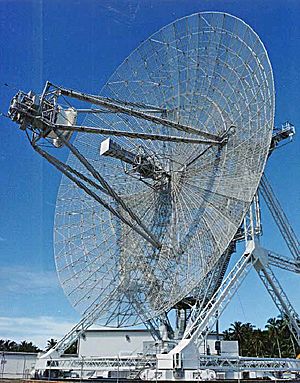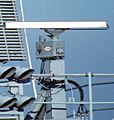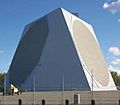Radar facts for kids
Radar is a cool machine that uses invisible radio waves to find objects like airplanes, ships, and even rain! Think of it like a bat using sound to "see" in the dark, but radar uses radio waves instead.
The main parts of a radar system are:
- The transmitter sends out the radio waves.
- The antenna helps direct these waves in a specific direction.
- The receiver then listens for the waves that bounce back from an object.
By measuring how long it takes for the waves to return, radar can figure out how far away an object is and where it's located. It can also tell how fast something is moving!
Radar was first invented in 1904 by a German scientist named Christian Hülsmeyer. He even got a special patent for his invention. Radar became super important and widely used during World War II to help detect enemy aircraft and ships.
The word RADAR itself was created in 1942. It's an acronym that stands for Radio Detection and Ranging. Before that, the British called it RDF, which meant Radio Direction Finding. Today, most people just think of "radar" as a regular word, not an acronym.
Contents
How Does Radar Work?
Radar works by sending out short bursts, or "pulses," of radio waves. These waves travel through the air at the speed of light. When they hit an object, like an airplane or a cloud, some of the waves bounce back towards the radar antenna.
The radar's receiver catches these bounced-back waves, which are called "echoes." By measuring the time it takes for a pulse to leave the radar and return as an echo, the system can calculate the distance to the object. If the object is moving, the frequency of the returning waves changes slightly, which helps the radar figure out its speed. This is called the Doppler effect.
What Is Radar Used For?
Radar is used in many different ways in our daily lives and in important industries:
Air Traffic Control
One of the most important uses of radar is in air traffic control. It helps controllers see where airplanes are in the sky, guiding them safely to and from airports. The FAA (Federal Aviation Administration) uses several types of radar for this:
- ARSR (Air Route Surveillance Radar) helps track planes flying between cities.
- ASR (Airport Surveillance Radar) is used to guide planes closer to airports.
- ASDE (Airport Surface Detection Equipment) helps controllers see planes and vehicles on the ground at busy airports.
- PAR (Precision Approach Radar) helps pilots land safely, especially in bad weather.
Weather Forecasting
Weather radar is super helpful for predicting the weather. It sends out radio waves that bounce off raindrops, hailstones, and snowflakes. This allows meteorologists to see where storms are, how strong they are, and which way they are moving. This helps us prepare for heavy rain, thunderstorms, or even tornadoes.
Other Cool Uses of Radar
- Speed Guns: Police use radar guns to measure the speed of cars on the road.
- Navigation: Ships use radar to navigate safely, especially in fog or at night, by detecting other vessels and land.
- Space Exploration: Scientists use radar to map the surfaces of other planets and moons, and to track satellites.
- Automotive Safety: Many modern cars have radar systems that help with features like adaptive cruise control and automatic emergency braking, detecting other cars around them.
Radar technology keeps getting better, helping us understand our world and stay safe in many different situations.
Images for kids
-
Experimental radar antenna, US Naval Research Laboratory, Anacostia, D. C., from the late 1930s (photo taken in 1945).
-
The first workable unit built by Robert Watson-Watt and his team
-
A Chain Home tower in Great Baddow, Essex, United Kingdom
-
Brightness can indicate reflectivity as in this 1960 weather radar image (of Hurricane Abby). The radar's frequency, pulse form, polarization, signal processing, and antenna determine what it can observe.
-
Pulse-Doppler signal processing. The Range Sample axis represents individual samples taken in between each transmit pulse. The Range Interval axis represents each successive transmit pulse interval during which samples are taken. The Fast Fourier Transform process converts time-domain samples into frequency domain spectra. This is sometimes called the bed of nails.
See also
 In Spanish: Radar para niños
In Spanish: Radar para niños














